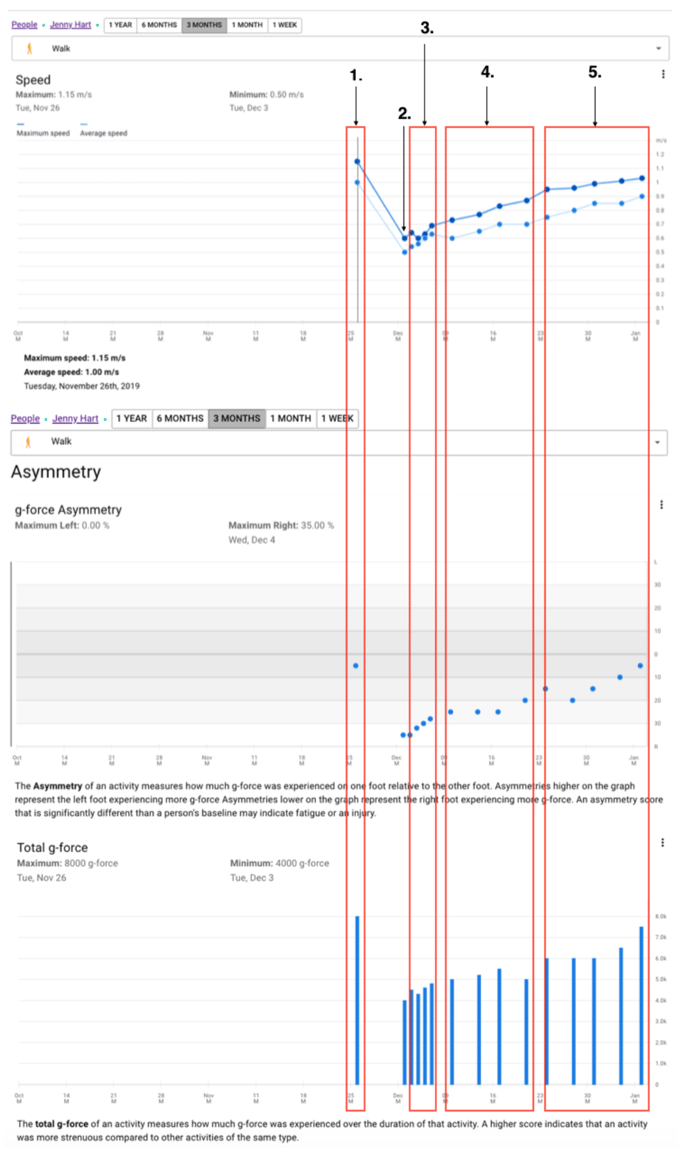Jenny is a 40-year-old woman with relapsing remitting multiple sclerosis (MS), who recently experienced an MS flare. At baseline, she was ambulating without a gait aid. Upon diagnosing her flare, it was noted that she had new lesions in her right cerebral hemisphere. Symptoms of her relapse have manifested in slowed gait, increased tone in her left lower limb, and reduced functional capacity. After treatment with IV corticosteroids for 5 days, Jenny was prescribed gait retraining (with and without an ankle-foot orthosis) with physiotherapy twice a week as her symptoms improved. Jenny already has baseline values for walking speed, limb asymmetry, and cumulative load. Plantiga assisted in measuring the therapeutic response to medical treatment, monitoring workload per therapy session, and assisted in clinical decision making regarding the need for a gait aid. Shown is 6 weeks worth of data: the 1st week represents her baseline gait characteristics, and the last 5 weeks represent her relapse along with treatment.

1. 0-1 week - (Typical non-symptomatic gait characteristics)
- Walking Speed - Jenny averages a walking speed of 1.0 m/s when she is not experiencing symptoms of her condition.
- % Asymmetry - Jenny averages a right asymmetry of 5% in her day-to-day living.
- Load - Jenny averages around 8000 g-forces during a typical 1 hour-long outpatient physiotherapy session.
2. 1st appointment - (Relapse of Symptoms) - After noticing increasing spasticity on her right side, Jenny schedules a check-up.
- Walking Speed - Jenny exhibits a relapse of symptoms and slows from an average of 1.0m/s to 0.5m/s.
- % Asymmetry - Since experiencing her relapse, Jenny notices difficulty using her left leg, resulting in a significant right limb asymmetry.
- Load - Since her increase in symptoms, Jenny is unable to maintain the same intensity of exercise as she would when she was non-symptomatic. Her functional capacity is assessed through the 2 Minute Walk Test and the 25-Foot Walk Test. She has a low capacity to withstand exercise, presenting a goal of increasing her activity level throughout her treatment.
3. 1-1.5 weeks - (Diagnosis of Condition + Outpatient Treatment (IV Corticosteroids + Physiotherapy)) - Since Jenny was diagnosed with an MS flare in the right cerebral hemisphere, her baseline hemiplegic gait pattern has worsened. She is prescribed IV corticosteroids and referred to outpatient physiotherapy for gait retraining and consideration for an ankle foot orthosis or gait aid.
- Walking Speed - During this period of treatment, her symptoms partially resolve and she increases from an average walking speed of 0.5 m/s to 0.63 m/s.
- % Asymmetry - Jenny decreases from an average right asymmetry of 35% to 28%.
- Load - Jenny increases from an average load of 4000 g-forces to 4800 g-forces during her physiotherapy sessions.
4. 2-4 weeks - (Outpatient Physiotherapy 2x Weekly)
- Walking Speed - During this period, Jenny is able to increase her walking speed (without a gait aid or AFO) from 0.6 m/s to 0.75 m/s.
- % Asymmetry - Along with walking speed, Jenny’s asymmetry during this period begins to normalize, going from a right asymmetry of 25% to a right asymmetry of 15%.
- Load - As Jenny begins to increase tolerance for exercise and speed of gait, her physiotherapy session load increases from 5000 g-forces to 6000 g-forces.
5. 4-6 weeks - (Outpatient Physiotherapy + Follow-up Doctors Appointment)
- Walking Speed - Jenny continues the progress of her treatment, and during this period she is able to increase her walking speed from 0.7 m/s to 0.9 m/s, a value within 10% of her pre-relapse average walking speed.
- % Asymmetry - Along with walking speed, her gait asymmetry normalizes to roughly 5% at the end of her treatment.
- Load - As Jenny is starting to feel symptom-free, she is walking more frequently and at her pre-relapse speed. In turn, she increases her load from 5000 g-forces to 7500 g-forces during this period of physiotherapy.
Summary:
After 5 weeks of out-patient physiotherapy, the symptoms of Jenny’s relapse have subsided and she is ambulating near her pre-relapse values. Note that Jenny’s baseline speed is below average for her demographic, and more importantly, her discharge gait speed of 0.9 m/s is a risk factor for falls. Jenny is thus fitted with a gait aid for use on uneven outdoor surfaces. As it is common for patients with relapsing-remitting multiple sclerosis to experience additional relapses, Jenny is recommended to return semi-regularly for assessment as her condition progresses.
.png?height=120&name=Plantiga%20lockup%20black%20(1).png)